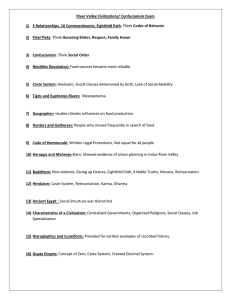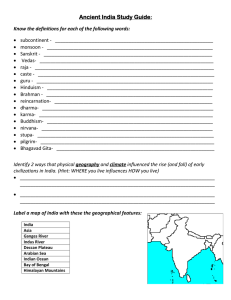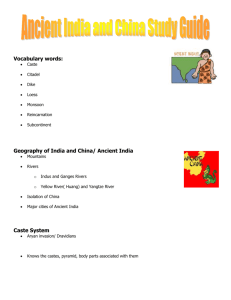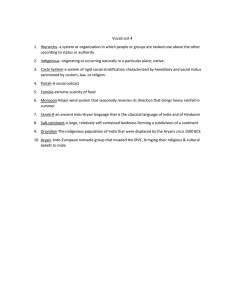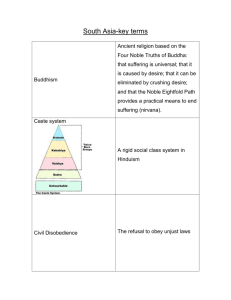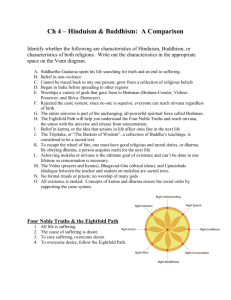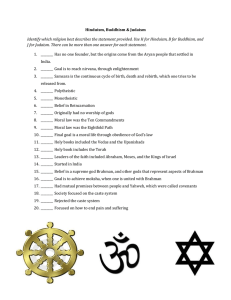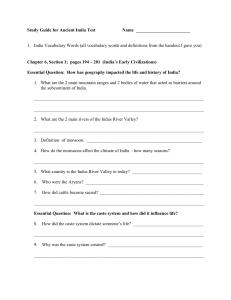Hinduism & Buddhism
advertisement
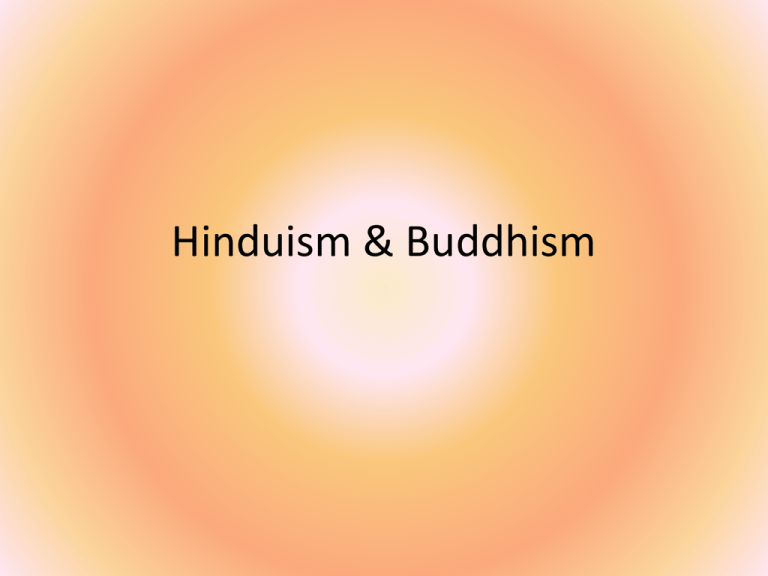
Hinduism & Buddhism Vocabulary List 5 1. 2. 3. 4. 5. Karma-A Sanskrit word meaning “action” that Hindus believe there will be an equal consequence Dharma-A Sanskrit word meaning “duty” or “virtue” that Hindus believe they must follow Samsara-A constant cycle of rebirth believed in by Hindus Nirvana- Ultimate bliss, release from suffering, desires, and reincarnation Enlightenment-Perfect understanding 6. Hinduism-Religion which focuses on doing your duty & good deeds to end the cycle of reincarnation 7. Buddhism-Religion which focuses on detachment from desires & meditation to achieve enlightenment 8. Reincarnation-the belief that the soul, upon death of the body, comes back to earth in another body or form. 9. Vedas- Hindu sacred writings 10. Sutras- Buddhist scripture Bell Ringer # 34 • What are the main theories of why the IRVC collapsed? • Based on what we have covered, which one do you think is most likely? What evidence best supports your theory? – This is not a right/wrong question, nobody is certain! Bell Ringer # 35 Take out your homework and respond to the following questions: • How does the belief in reincarnation reinforce the caste system? – Try to incorporate as much detail as possible! • What three religions were mentioned in the text? – What can you tell me about those religions? 1. POP QUIZ!!! (v. 1) In Hinduism, what is it called when the soul breaks free of samsara, the cycle of death and rebirth? a) b) c) d) 2. 3. True or false, the founder of Hinduism is Siddhartha Gautama In Buddhism, what is the path of to Nirvana? a) b) c) d) 4. 5. Moksha Enlightenment Nirvana None of the above Bodhi The Eightfold Path The Buddha Moksha True or false, Buddhism rejected the caste system and allowed women and commoners to join religious orders? The central belief of Jainism is… a) b) c) d) Violence Non-Violence Donate to the poor Convert followers *Bonus*- What are the sacred mounds called that contain relics of Buddha? 1. Pop Quiz!!! (v. 2) In Buddhism, what is it called a person has followed the eightfold path and achieved a release from selfishness and pain? a) b) c) d) 2. 3. True or false, the founder of Hinduism is Siddhartha Gautama The central belief of Jainism is… a) b) c) d) 4. 5. Moksha Enlightenment Nirvana None of the above Non-Violence Donate to the poor Convert followers Worship of ancestors True or false, the religious texts of Hinduism are called the Vedas In Hinduism, what is it called when the soul breaks free of samsara, the cycle of death and rebirth? a) b) c) d) Moksha Enlightenment Nirvana None of the above *BONUS* Hindus consider Buddha to be a reincarnation of which Hindu god? POP QUIZ!!! (v. 3) 1. True or false, Hinduism and Buddhism both contain the belief in reincarnation? 2. The central belief of Jainism is… a) b) c) d) Worship of ancestors Donate to the poor Convert followers Non-Violence 3. True or false, the founder of Buddhism is Siddhartha Gautama 4. In Buddhism, what is the path of to Nirvana? a) b) c) d) 5. Bodhi The Eightfold Path The Buddha Moksha In Hinduism, what is it called when the soul breaks free of samsara, the cycle of death and rebirth? a) b) c) d) Moksha Enlightenment Nirvana None of the above *BONUS* What are Buddhist religious orders called? Popcorn Reading • “The Indo Europeans” – We’re skipping the section on the Hittites • After we read this section as a class, create a GoogleDoc with a partner and answer question #1 – You can skip the terms “Anatolia” and “Hittites” – Be prepared to share your responses! Aryan Invasion Theory • C. 2000-1500 BCE, a group of nomadic warrior-herders called the Aryans Invaded the lands of the Indus River Valley • The Aryans were from Eastern Europe between the Black Sea and Caspian Sea • The present Harappan civilization was already in decline and unable to repel the Aryans Aryans Indo European Languages Blending of Cultures • The Aryans brought with them their own language, called Sanskrit and religious and cultural beliefs. • The indigenous population (sometimes referred to as Dravidian) people eventually became intermixed with the Aryan people and the two cultures together make up what is now much of the culture of modern India. • Hinduism, the major religion of India, was a mixture of Aryan and perhaps some IRVC beliefs. • The caste system, which keeps people in strict social classes, was brought to India by the Aryans. Development of Caste System • Aryans divide people in classes (castes) • Based originally by varna or skin color – Aryans were lighter skinned than Dravidians – Aryans occupied the top castes • People in the lower castes were looked down on. • No social mobility, cannot go up or down ranks • The caste system was very effective in keeping social order but it was rigid. – Strict rules on who you could marry, what kind of job you could have, where you live, and who you could speak to • Hinduism reinforces caste system Hinduism • The Aryans and the Indus Valley culture eventually produced Hinduism. • Polytheistic/Monotheistic • Supreme God, lesser deities are versions • Three major gods create a trinity: – Brahma the creator – Vishnu the preserver – Shiva the destroyer Hinduism Continued • Religious texts called “Vedas” that record the beliefs of the Aryans, written in Sanskrit • Considered to be perhaps the oldest continuing religion in the world • Hinduism differs from other religions like Christianity, Judaism and Islam in that there is no one single founder or one set of beliefs that must be followed. Reincarnation • Hindus believe that after a person dies, they will be re-born as some other creature or thing. • What you are re-born as depends on your “Karma” or the deeds you did in your previous life. – If you did good deeds, you will reborn into a higher, better life. – If you had bad Karma, you may be re-born as an insect or even a tree. Reincarnation Continued • Karma- Sanskrit word that means “action” – Good or bad actions will have equal consequences – Karma rolls over into next lifetime • Dharma- “duty” “virtue” or “morality” – Set of rules to guide your life – Plays into the caste system • Constant cycle of rebirth called Samsara • Ultimate goal is to end this rebirth, called moksha Castes • India’s caste system is divided into many different classes, each with its own job. • The highest class is the Brahmins, or priests. They have great authority and respect. • The next level are Kshatriya, who are the warriors or land-owners. They are often in the wealthy, ruling class. Castes, cont. • Next come the Vaishya, who are the merchants and artisans. They are the people who sell products. • The lowest level are the servants and farmers. They are called Shudra. They are very important because they provide food and goods for society but did not have high status. “Outcasts” • The lowest group in India are the Harijan. They are also called the “untouchables” or “outcasts” because they are not even considered part of the caste system. • They do the worst jobs in the community such as cleaning sewers and sweeping the streets. • Members of the caste system were not even supposed to have the shadow of an untouchable touch them. • The Harijan believed that the only way to get out of their situation was to do everything without complaint (aka dharma) so they could be reborn into a higher caste in the next life. Buddhism • Founded c. 600 BCE by Siddhartha Gautama (the Buddha) • Born into the Kshatriya caste (warrior class) in present day Nepal • Wealthy prince who was kept isolated inside a beautiful palace and not exposed to the suffering of others • One day he left the walls of his palace and saw the pain and misery of life, characterized by three men: an old man, a sick man, and a dead man (One cannot escape age, disease, or death) • He tried several ways to meditate and find peace until he finally he came up with his own way; Buddhism. Meditation • Buddha gained enlightenment under the Bodhi tree • Meditation is central – Develop awareness – Change perception – Increase concentration – Break attachment Buddhism Continued • Life is full of suffering – Suffering is caused by attachment/desires – Suffering ends when attachment ends • No worship of gods or god • Reincarnation • Impermanence (nothing lasts forever, good or bad) • Meditation to become Enlightened, reaching a state of Nirvana. Four Noble Truths • The basic foundation of Buddhism are the four Noble Truths • Four Noble Truths 1 Existence of Dukkha (suffering) 2 Dukkha is caused by attachment 3 Dukkha can be overcome 4 The path to overcoming Dukkha (Eightfold Path) • Think: 1= symptoms, 2=diagnosis, 3=prognosis, 4=prescription Eightfold Path • Eightfold Path “The Right” Understanding, Thought, Speech, Action, Effort, Mindfulness, Concentration, Livelihood • The “path” of NT #4 • No particular order • Support and reinforce one another Vedic Age of India • C. 1750-500 BCE the vedas were composed • Passed down orally, written down later • Eventually written in Sanskrit, Hymns, spells, charms, and rituals of the Ayrans – Some stories tell of conflict between the Ayrans and Dravidians – Alien language, dark completion, strange gods • Settlements shift to warlike nomadic clans from peaceful cities of IRVC • Clans then morph into kingdoms classical India Ganges River • IRVC collapse, evidence points that they may have relocated here – Center of civilization shifts to here, may or may not be IRVC • Mentioned in the Vedas • Sacred to Hindus C. 500 BCE Empires of India • Maurya- 321 BCE, Chandragupta Maurya unifies eastern and northen India, by 300 BCE most of India unified – High taxes (50% of crops) – Large army – Strict • 269 BCE grandson Asoka takes over – – – – – Converts to Buddhism Religious tolerance Roads & trade “Lawgiver” think Hammurabi’s code in Sanskrit Dies, things fall apart Empires cont. • Gupta Empire- 320 CE Chandra Gupta takes power in the north, eventually unifies most of India • “Golden Age” many advancements in many fields • 500 CE in decline 500 healing plants identified 1000 diseases classified Printed medicinal guides Plastic Surgery Gupta Achievements Kalidasa Literature Medicine Inoculations Gupta India C-sections performed Decimal System Mathematics Concept of Zero PI = 3.1416 Solar Calendar Astronomy The earth is round Study Guide • • • • • • • • • • • • Dravidian Aryan Harappa Harappan/IRVC IRVC Economy IRVC City Layout Mohenjo-Daro Lothal Sub-continent Sanskrit Vedas Monsoon • • • • • • • • • • • • Buddhism Hinduism Reincarnation Karma Dharma Samsara Moksha Caste System Pariah Siddhartha Gautama Four Noble Truths Eightfold Path
